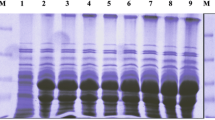Abstract
BmK ITa1 is an insect-specific neurotoxin from the Chinese scorpion Buthus martensi Karsch (Bmk). We succeeded in obtaining biologically active recombinant BmK ITa1 protein by simultaneous expression in insect cells of BmK ITa1 cDNA with an amidating enzyme expressed by the rat peptidylglycine α-amidating monooxygenase (PAM) gene. We investigated the insecticidal efficacy of recombinant BmK ITa1/W (without coexpression of PAM), and of BmK ITa1/A (with coexpression of PAM) in 5th instar Bombyx mori, by injecting these recombinant toxins into larvae. The lethal time for 50% of larvae (LT50) was 9 h for BmK ITa1/A and 17 h for BmK ITa1/W. At 19 h after injection all of the larvae exposed to BmK ITa1/A had been killed, whereas only half of the larvae exposed to BmK ITa1/W had been killed. These results show that the simultaneous expression of an amidating enzyme can result in apparently higher insecticidal activity of BmK ITa1.
Similar content being viewed by others
References
Catterall, W. A. (1979) Binding of scorpion toxin to receptor sites associated with sodium channels in frog muscle. J. Gen. Physiol. 74, 357–391.
Carbonell, L.F., Hodge, M.R., Tomalski, M.D., and Miller, L.K. (1988) Synthesis of a gene coding for an insect-specific scorpion neurotoxin and attempts to express it using baculovirus vectors. Gene 73, 409–418.
Zhihong, J., Yuhong, Y., Laigeng, X., Xinying, Y., Qichang, X., Boliang, L., et al. (1998) Functional expression of rat peptidylglycine α-amidating monooxygenase in CHO cells and its use in in vitro amidation. Chinese J. Biotechnol. 14 (2), 125–132.
Hasemann, C. A. and Capra, J. D. (1990) High-level production of a functional immunoglobulin heterodimer in a baculovirus expression system. Proc. Natl. Acad. Sci. USA 87, 3942–3946.
Xiong, Y. M., Ling, M. H., Wang, D. C., and Chi, C. W. (1997) The cDNA and genomic DNA sequences of a mammalian neurotoxin form the scorpion Buthus martensi Karsch. Toxicon 35, 1025–1031.
McCutchen, B. F., Choudary, P. V., Crenshaw, R., Maddox, D., Kamita, S. G., Palekar, N., et al. (1991) Development of a recombinant baculovirus expressing an insect-selective neurotoxin: potential for pest control. Biotechnology 9, 848–851.
Yu-Hong, Y., Hu, C., Chao, Y., Rong, Z., Da-Fu, C., Xiang-Fu, W., et al. (2000) In Vitro amidating processing of products expressed by gene engineering. Acta Biochim. Biophys. Sinica. 32, 312–315.
Suzuki, K., Shimoi, H., Iwasaki, Y., Kawahara, T., Matsuura, Y., and Nishikawa, Y. (1990) Elucidation of amidating reaction mechanism by frog amidating enzyme, Peptidylglycine α-Amidating Monooxygenase, expressed in insect cell culture. Embo. J. 9, 4259–4265.
Author information
Authors and Affiliations
Corresponding author
Rights and permissions
About this article
Cite this article
Liu, Z., Yang, G., Li, B. et al. Cloning, co-expression with an amidating enzyme, and activity of the scorpion toxin BmK ITa1 cDNA in insect cells. Mol Biotechnol 24, 21–26 (2003). https://doi.org/10.1385/MB:24:1:21
Issue Date:
DOI: https://doi.org/10.1385/MB:24:1:21




